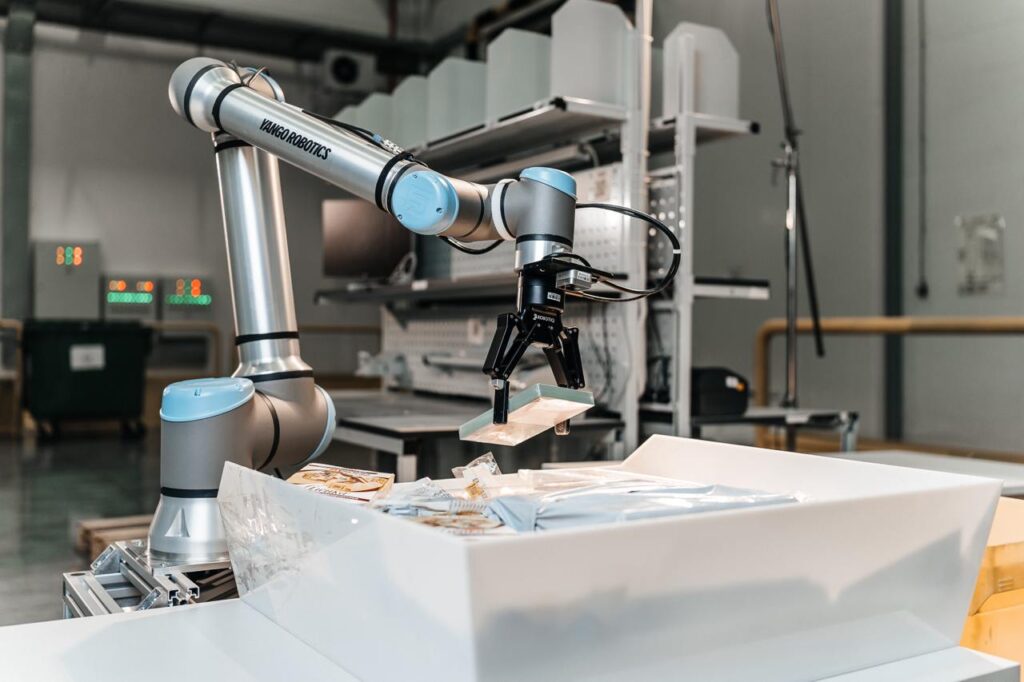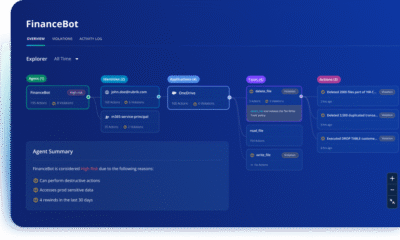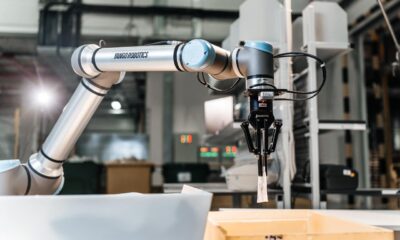Tech Features
The Future of Work-Integrated Learning: Embedding HR Tech Practices in Higher Education

Professor Fiona Robson, Head of the School of Social Sciences and Edinburgh Business School, Heriot-Watt University Dubai

Universities have a responsibility to prepare students for their future career in terms of both skills and knowledge. In an increasingly technological world, managers of the future need to understand the capabilities of HR tech as well as being able to use it.
Exposing students to HR tech platforms can help to prepare them for their future career in HR in terms of skills but also understanding what is going on in the HR space – understanding the priorities and why use of technology is growing. Being familiar and comfortable with HR tech might help them to stand out in the graduate marketplace and from an employer’s perspective could help them hit the ground running. Being able to analyse data to inform organisational decisions is critical and HR tech gives them the ability to get good data and then learn how to use it to make appropriate data-driven decisions.
Real play rather than role play is particularly helpful for students as the learning is more meaningful, and they can visualise what would happen in the workplace. Therefore, using software which is being used in real organisations will add great value to their learning experience and what their future role might involve. Where University academics have strong relationships with industry, they may be able to use real data so that the students get a realistic experience and understand the complexity of what organisations have to contend with.
Where the HR tech has the capability to provide commentary based on the student performance in using it, this is a further source of information of formative feedback which helps students with their academic and personal development. Developing students’ confidence in using tech should not be underestimated as if they have the knowledge but are afraid to use it, their impact will be limited. Ideally, organisations are looking for graduates who are comfortable in learning to use new programmes and understand some of the teething troubles that can emerge when introducing new tech.
Involving HR professionals within the classroom adds significant value to students and helps them to understand the diverse nature of working in an HR team. Therefore where learning to use the HR tech platform can be married with having an HR professional to talk them through how it can be used and the impact of using it, this would further strengthen their learning and experience. There can also be benefits for HR professionals, as they can gain perspectives from students that may differ from those they encounter in the workplace—particularly if they are interested in potential generational differences. Sharing their own knowledge and skills and presenting to University students can also be very beneficial to the personal and professional development of the HR professional.
Organisations are ideally looking for graduates who are confident in using technology and open to trying new systems and ideas, and therefore, if they have been exposed to different types of tech, this could give them an advantage. They can also learn about some of the wider things about technology implementation – for example, issues around ethics as well as the data protection and legal implications of having access to sensitive and confidential information.
Opening Doors with Internships
Internship programmes provide great insights into the industry and allow students to see the links between theory and practice. It also enables them to see all of the different internal and external factors which can have an impact on organisations, and this can be very eye-opening for them. Understanding the roles of different stakeholders is usually one of the key learning points from internships.
In the classroom, we can teach students the theory about organisational culture and individual and team dynamics; however, an internship is where they can see what this actually looks like. Being able to observe how different departments collaborate may help them to make sense of some of the topics they have studied as part of their degree programme.
We shouldn’t underestimate the importance of learning to build relationships in the workplace and to recognise and respond to issues like organisational politics. For some students, exposure to an internship can help cement their career aspirations in identifying which areas of business they find most interesting, and for some students they will be attracted to roles that they may previously not have been aware of.
As most businesses now have an international aspect, it is also valuable for interns to learn about the different angles of internationalisation and what this means for people in their day-to-day activities. Typically they may recognise it is common for organisations to have international customers but may not have considered international supply chains and the complexities of having employees in different countries which operate under different jurisdictions. It may also reiterate the importance of developing the cross cultural skills that they are taught by their lecturers.
If students’ internships are successful and they are identified as being potential talent of the future, the organisation may begin a longer-term relationship with them. For example, they may allow them to focus their dissertation within the organisation or offering them a job once they graduate.
Tech Features
How are leaders in the Middle East using AI to solve for supply chain issues

Attributed by Harsh Kumar, Chief Strategy Officer, Shipsy
The Middle East’s logistics sector is undergoing a fundamental change as industry leaders embrace AI to tackle region-specific challenges and build the foundation for autonomous supply chain operations. “In the wake of the fourth industrial revolution, governments and businesses across the Middle East are beginning to realise the shift globally towards AI and advanced technologies. We estimate that the Middle East is expected to accrue 2% of the total global benefits of AI in 2030. This is equivalent to US$320 billion,” highlights a PwC Middle East report.
When it comes to making supply chains autonomous, logistics leaders in the Middle East agree that there are some inherent challenges in the region that hinder growth and that they are working towards addressing the same.
Addressing the Middle East’s Obstacles to Autonomous Supply Chains
Inaccurate addresses remain one of the most critical pain points for Middle Eastern logistics operations, directly impacting productivity, costs, and customer experience. The region’s diverse linguistic landscape and inconsistent address systems have made last-mile delivery particularly challenging.
In the Middle East, inefficient address structure often results in packages and letters being addressed only with a recipient’s name, city, and country, lacking a specific delivery address. Courier services are typically provided with just a name and mobile number, requiring them to investigate and determine the intended delivery location. According to a report by Logistics Middle East, incorrect addresses can potentially impact more than $7.42 billion in eCommerce revenue in the Middle East.
“AI’s success and differentiation from any other technology before it, will depend on its ability to solve region-specific challenges. Unlike banking and financial services sectors, logistics and supply chain operations often deal with fragmented processes and disconnected systems. AI is uniquely positioned to bridge these gaps by harmonizing data, streamlining workflows and enhancing efficiency across the entire value chain all of which have a direct impact on operational productivity.” said Iyad Kamal, ex COO of Aramex.
Incorrect addresses also create another challenge of driver productivity and retention. With retail customer expectations rising and delivery times shortening, logistics providers will need to focus on making it easier for drivers to complete their work, get the right information at the right time to ensure they deliver a better customer experience.
The challenge compounds due to a flawed hypothesis in route optimization which does not take into consideration real-world variables when allocating deliveries creating delays and impacting driver productivity. Another critical problem that needs to be addressed is financial settlements. Validating data for settlements remains a heavily manual and time-intensive process. It will not be incorrect to say that only about 10% of invoices are accurately validated, as the human effort required is significant. This results in a higher risk of inaccuracies in settlement. AI agents can help here by analyzing delivery proofs against trip data and automatically calculate delay fees using GPS timestamps and contractual rates.
How leaders are moving from Guesswork to Data-Driven Precision
Resource allocation has traditionally relied on intuition, resulting in suboptimal vehicle utilization and excessive mileage. Digital Twin technology is changing this paradigm by enabling logistics providers to run scenario analyses and predict the impact of different allocation strategies before implementation.
Real-time incident management has also evolved beyond manual dashboard monitoring. Autonomous monitoring agents now continuously check operations against KPIs, detecting anomalies like delays or harsh braking incidents. When issues arise, these agents assess impact, proactively communicate updated ETAs to customers, and suggest rescheduling options, thereby drastically reducing resolution times.
Aujan Coca-Cola Beverages Company is leveraging Agentic Incident Management, AI-powered dynamic route optimisation and load balancing and Agentic Control Tower to enhance customer experience by ensuring ETA adherence and real-time visibility.
Fair compensation and equitable workload distribution emerged as critical for combating driver attrition, with leaders emphasizing that rewards must be immediate rather than deferred to maintain motivation. Customer-centric execution requires moving beyond basic data matching. AI-enabled semantic matching creates comprehensive customer profiles that preserve delivery preferences across different drivers and addresses, ensuring consistent service quality.
“Verifying every transaction and validating every invoice, continue to be a massive overhead for supply chain leaders even in 2025. Companies that can leverage AI to automate highly human-intensive processes will unlock velocity as an advantage, making it harder for their competition to catch up.” said Soham Chokshi, Co-Founder and CEO of Shipsy, while emphasizing AI’s role in logistics.
The Road Ahead
Logistics leaders in the Middle East envision autonomous, intelligent, and customer-centric supply chains powered by agentic AI that independently solves complex problems. However, the success of these systems hinges on a human-in-the-loop approach. Balancing algorithmic optimization with human expertise, such as local knowledge and driver preferences, is essential to address the region’s unique challenges, like inefficient address systems. By integrating continuous monitoring and predictive intervention, AI can shift operations from reactive to proactive, but human oversight ensures adaptability and accuracy. This synergy between AI capabilities and human insight drives resilient, efficient, and customer-focused logistics networks.
As the region’s logistics sector continues its digital transformation, these AI-driven foundations are positioning Middle Eastern supply chains at the forefront of global innovation in autonomous operations.
Tech Features
Yango Tech: Four Game-Changing Tools Revolutionising Retail Operations

Consumer demand in the Middle East is rising fast, driven by omnichannel shopping habits and the expectation of speed and accuracy. AI-powered automation has become essential for retailers to keep up. McKinsey projects AI contribute up to $150 billion to GCC economies by 2030, while the UAE’s retail sector is forecast to reach $74.87 billion by 2028. Yango Tech has outlined four key tools retailers can use to succeed in this environment.
1. AI Agents
AI agents are transforming retail with several capabilities. On the front end, they deliver contextually relevant recommendations in real time, tailoring offers based on location, cultural moments, or the weather, while conversational AI enriches the journey with human-like assistance in native languages. They also harness predictive capabilities by analysing unstructured data, from social media to past purchase behaviour, to anticipate shifts in demand and refine pricing or promotional strategies. Ahead of Eid Al-Adha, for instance, they might spotlight premium meat cuts or traditional Arabic sweets, helping retailers unlock revenue increases of 10–15%.
Beyond customer-facing roles, AI agents drive efficiency behind the scenes. Procurement agents compose RFPs, compare vendor offers, and execute sourcing decisions directly in procurement systems, saving up to 80% of manual effort. Replenishment agents forecast inventory gaps, adjust orders dynamically, and use computer vision to redistribute stock or reroute deliveries, boosting accuracy to 95% and cutting waste. Content management agents accelerate time-to-listing by auto-generating product cards, adapting content to trends, and ensuring consistency across markets. Pricing agents track competitor SKUs and demand elasticity in real time, optimising promotions and delivery fees to protect margins while sustaining competitiveness.
2. Smart Price Tags
Price intelligence has become crucial for staying competitive with today’s informed and price-sensitive shoppers. Dynamic pricing algorithms can review millions of products in minutes, optimising strategies at a speed human decision-making cannot match. By applying ML to track competitor pricing, market trends, and demand elasticity, retailers can adjust prices in real time, boosting gross merchandise value by up to 20%. These systems also factor in seasonal shifts, fluctuating supply costs, and product shelf life, while surge pricing AI manages delivery fees or order values during peak periods to protect margins. Digital twin technology strengthens this further by creating virtual replicas of stores, streaming data from sensors and cameras into pricing systems. This real-time visibility into shelves and product movement ensures that pricing decisions are tied directly to availability, enabling retailers to reduce waste, streamline operations, and maintain customer trust while driving profitability.
3. Computer Vision
Computer vision (CV) is redefining how retailers manage store layouts and product assortments by moving beyond static, manually updated plans. Instead of relying only on historical sales data, AI agents equipped with CV analyse real-time customer traffic and interactions to continuously optimize shelf arrangements and product placement. This creates store environments that adapt dynamically to shopper behaviour, boosting sales and improving the overall experience. CV also provides granular insights into store-specific conditions, from equipment to layout constraints, enabling smarter decisions. Beyond the shop floor, warehouses use CV to monitor dispatch accuracy, logistics teams track the condition of trucks in transit, and managers can oversee staff performance in real time. Paired with augmented reality, the technology also delivers richer customer engagement, allowing shoppers to virtually try on clothes or visualize furniture directly in their homes.

4. Robotic automation
Robotics is moving from concept to necessity in retail. In warehouses, robotic pickers trained through behavioural cloning by human experts and thousands of real-world warehouse scenarios reach up to 95% picking accuracy. With the repetitive warehouse tasks taken over, staff can focus on higher-value work and boost productivity.
Autonomous delivery robots are also emerging as practical solutions for dense urban areas. Equipped with high-precision navigation, they operate 24/7 and cut emissions compared to traditional vehicles. They complement existing fleets by reaching locations where larger vehicles cannot, supporting zero-emission urban logistics. As battery technology and urban infrastructure advance, their role in retail operations will continue to expand.
Tech Features
From Control to Intelligence: Why the GCC Is Poised to Lead the Next Security Evolution

By Wei Huang, Chief Technology Officer, Anomali

In cybersecurity, each era is defined by a shift in architecture. Firewalls dominated the 2000s. Endpoint protection and identity controls shaped the 2010s. Today, we are entering a new phase — one where cloud-native platforms, real-time data correlation, and AI-powered analytics are no longer optional but essential.
Nowhere is this transition more timely than in the Gulf Cooperation Council (GCC) region. As cloud adoption accelerates across the United Arab Emirates (UAE), Saudi Arabia, and neighboring states, national cybersecurity resilience has become a critical pillar of digital transformation. GCC organizations have a unique opportunity to leap ahead — bypassing legacy limitations and adopting next-generation security architectures purpose-built for today’s advanced threats.
The Core Shift: Security Is Now a Data Problem
For decades, cybersecurity focused on control: firewalls, proxies, endpoint agents, and network gateways. While these tools remain foundational, today’s adversaries have evolved. Attackers exploit gaps between systems, bypass controls through misconfigurations, and evade siloed defenses with increasing sophistication.
The result is a fundamental architectural shift: modern security is no longer solely about enforcing control — it’s about processing data. Effective defense requires ingesting, normalizing, and correlating telemetry across every layer of the enterprise: endpoints, cloud workloads, SaaS platforms, identity systems, and external intelligence feeds. When combined with AI-powered analytics, this data-driven approach transforms raw telemetry into actionable insights, allowing defenders to outpace attackers, rather than merely react, once an attack has been detected.
Cloud-Native Design: The Architecture That Scales
Traditional security information and event management (SIEM) systems and on-premises platforms struggle to meet the scale, flexibility, and speed required in modern hybrid environments. Cloud-native architectures, by contrast, offer elastic scalability that aligns directly with national digital transformation priorities across the GCC.
However, the scale of telemetry introduces new challenges. Global cloud storage volumes are projected to reach 100 zettabytes by the end of 2025. Storing and processing such massive datasets can quickly become prohibitively expensive — unless managed with modern design principles.
The solution lies in the security data lake: a unified, long-term, cloud-native repository capable of retaining years of structured and unstructured security data. Unlike legacy systems limited to weeks or months of visibility, a security data lake enables continuous historical analysis for threat hunting, compliance, and investigations.
Crucially, modern architectures decouple storage and compute. Instead of permanently allocating compute resources (as most legacy platforms do), serverless designs apply compute power only when needed, dramatically reducing cost while enabling faster analysis.
For example, by leveraging serverless infrastructure on Amazon Web Services (AWS), Anomali enables compute bursts across thousands of nodes, delivering correlations and searches up to 1,000 times faster, at a fraction of the cost of traditional solutions. This approach is particularly aligned to national resilience goals, where speed and efficiency are essential.
Real-Time Correlation at Petabyte Scale
Today’s attackers automate their reconnaissance, probing continuously for vulnerabilities across every layer of the enterprise. To keep pace, organizations must reduce detection time and response costs, which demands real-time correlation across petabytes of data.
By integrating telemetry from multiple domains — including firewalls, endpoints, SaaS platforms, identity providers, and threat intelligence — organizations gain visibility into attacks that no single control would detect alone. For GCC enterprises expanding hybrid and multi-cloud infrastructures, the ability to correlate across these diverse sources in real time is mission-critical.
AI Delivers Context, Not Just Alerts
Artificial intelligence is now widely marketed in cybersecurity, but much of it offers opaque conclusions without transparency — effectively adding noise rather than clarity.
True AI-powered defense must provide explainability. Anomali applies chain-of-thought (CoT) AI reasoning, ensuring every detection includes the rationale, evidence, and audit trail behind each decision. This transparency builds analyst confidence and accelerates skill development, particularly valuable as GCC nations continue building local cybersecurity talent and operational maturity.
Intelligence Closes the Gaps Left by Controls
Even with modern defenses in place, critical gaps remain. Studies show that many endpoint detection and response (EDR) solutions still miss up to 30% of advanced threats, thanks to sophisticated evasion techniques, configuration gaps, or partial visibility. Firewalls suffer similar challenges: misconfigurations and limited context allow adversaries to slip past perimeter defenses.
This is where intelligence plays a decisive role. By unifying diverse telemetry and correlating billions of daily security events, modern security analytics platforms fill these blind spots, delivering full-spectrum detection across hybrid environments. For critical infrastructure, financial institutions, and government entities in the GCC, closing these gaps is no longer optional — it is a resilience imperative.
Agentless, Serverless, Effortless
Managing thousands of endpoint agents introduces complexity, operational risk, and resource overhead. Cloud-native platforms eliminate much of this friction by integrating directly with cloud platforms, SaaS services, and enterprise infrastructure via secure APIs, allowing telemetry ingestion without deploying additional agents.
For organizations balancing hybrid complexity with cloud-first strategies, agentless deployment models dramatically simplify operations — enabling faster rollout, lower risk, and greater agility.
Why the GCC Is Uniquely Positioned to Lead
The UAE, Saudi Arabia, and neighboring GCC nations are investing heavily in smart cities, digital economies, and next-generation public services. These national ambitions require security platforms that are scalable, adaptive, intelligent, and capable of evolving alongside rapid technological change.
Cloud-native, AI-powered, intelligence-driven security operations are no longer a distant vision but an operational necessity. By embracing these architectures, GCC enterprises and governments are positioned not only to meet today’s security demands, but to set a global standard for the future of cyber defense.
The time to shift from fragmented controls to unified intelligence is now. The future of security isn’t about deploying more tools — it’s about building smarter platforms.
And the GCC is ready.
Wei Huang is the Chief Technology Officer at Anomali, a global leader in intelligence-driven cybersecurity solutions.
-

 Tech News1 year ago
Tech News1 year agoDenodo Bolsters Executive Team by Hiring Christophe Culine as its Chief Revenue Officer
-

 VAR7 months ago
VAR7 months agoMicrosoft Launches New Surface Copilot+ PCs for Business
-

 Tech Interviews2 years ago
Tech Interviews2 years agoNavigating the Cybersecurity Landscape in Hybrid Work Environments
-

 Tech News4 months ago
Tech News4 months agoNothing Launches flagship Nothing Phone (3) and Headphone (1) in theme with the Iconic Museum of the Future in Dubai
-

 Tech News2 years ago
Tech News2 years agoBrighton College Abu Dhabi and Brighton College Al Ain Donate 954 IT Devices in Support of ‘Donate Your Own Device’ Campaign
-

 Editorial11 months ago
Editorial11 months agoCelebrating UAE National Day: A Legacy of Leadership and Technological Innovation
-

 VAR1 year ago
VAR1 year agoSamsung Galaxy Z Fold6 vs Google Pixel 9 Pro Fold: Clash Of The Folding Phenoms
-

 Cover Story8 months ago
Cover Story8 months agoUnifonic Leading the Future of AI-Driven Customer Engagement























